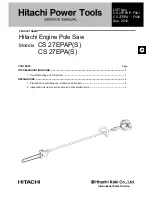
English
– 9
SAFETY INSTRUCTIONS
General working instructions
Basic safety rules
•
Look around you:
- To ensure that people, animals or other things cannot affect
your control of the machine.
- To make sure that none of the above come into contact with
the cutting blade.
•
Do not use the machine in bad weather, such as dense
fog, rain, strong wind, intense cold, etc. Working in bad
weather is tiring and can lead to dangerous conditions,
e.g. slippery surfaces.
•
Never start to work with the power cutter before the
working area is clear and you have a firm foothold. Look
out for any obstacles with unexpected movement. Ensure
when cutting that no material can become loose and fall,
causing operating injury.Take great care when working on
sloping ground.
•
Make sure that no clothes or parts of the body come in
contact with the cutting equipment when it is rotating.
•
Keep at a safe distance from the cutting equipment when
it is rotating.
•
The guard for the cutting equipment must always be on
when the machine is running.
•
Ensure that the working area is sufficiently illuminated to
create a safe working environment.
•
Do not move the machine when the cutting equipment is
rotating.
•
Always ensure you have a safe and stable working
position.
•
Make sure that no pipes or electrical cables are routed in
the area to be cut.
Cutting
General
•
Start cutting with the machine running at maximum speed.
•
Always hold the machine in a firm grip with both hands.
Hold it so that the thumbs and fingers grip round the
handles.
Cutting technique
The technique described below is of a general character.
Check information for each blade regarding individual cutting
characteristics (for example, a diamond blades requires less
feeding pressure than an abrasive discs).
•
Support the work piece in such a way that it is possible to
predict what will happen, and so that the cut remains open
while cutting.
•
Check that the blade is not in contact with anything when
the machine is started
•
Always cut at maximum speed.
•
Start cutting smoothly, allowing the machine to work
without forcing or pressing in the blade.
•
Move the blade slowly forwards and backwards to achieve
a small contact area between the blade and the material
to be cut. This reduces the temperature of the blade and
ensures effective cutting.
!
WARNING! This section describes basic
safety directions for using a power cutter.
This information is never a substitute for
professional skills and experience. If you get
into a situation where you feel unsafe, stop
and seek expert advice. Contact your dealer,
service agent or an experienced power
cutter user. Do not attempt any task that you
feel unsure of!
!
Only use the machine in areas with good
ventilation. Neglect can result in serious
injury or death.
!
WARNING! The safety distance for the power
cutter is 15 metres. You are responsible to
ensure that animals and onlookers are not
within the working area. Do not start cutting
until the working area is clear and you are
standing firmly.
!
WARNING! Overexposure to vibration can
lead to circulatory damage or nerve damage
in people who have impaired circulation.
Contact your doctor if you experience
symptoms of overexposure to vibration.
Such symptoms include numbness, loss of
feeling, tingling, pricking, pain, loss of
strength, changes in skin colour or
condition. These symptoms normally appear
in the fingers, hands or wrists. The risk
increases at low temperatures.
Summary of Contents for 396K
Page 23: ......









































